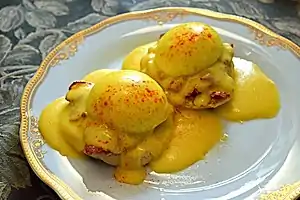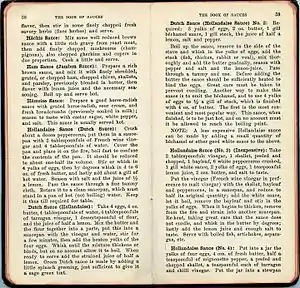Hollandaise sauce
Hollandaise sauce (/hɒlənˈdeɪz/ or /ˈhɒləndeɪz/; French: [ɔlɑ̃dɛz]), meaning Dutch sauce in French,[1] is a mixture of egg yolk, melted butter, and lemon juice (or a white wine or vinegar reduction). It is usually seasoned with salt, and either white pepper or cayenne pepper.
 Hollandaise sauce served as part of eggs Benedict with a dash of paprika | |
| Type | Sauce |
|---|---|
| Place of origin | |
| Main ingredients | Egg yolk, liquid butter, lemon juice |
It is well known as a key ingredient of eggs Benedict, and is often served on vegetables such as steamed asparagus.[2][3][4]
Origins

Sauce hollandaise is French for "Hollandic sauce".[note 1] The first documented recipe is from 1651 in La Varenne's Le Cuisinier François[7] for "asparagus with fragrant sauce":[8]
make a sauce with some good fresh butter, a little vinegar, salt, and nutmeg, and an egg yolk to bind the sauce; take care that it doesn't curdle[8]
However, the name was given during the Franco-Dutch war.[9][10]
There is a popular theory that the name comes from a recipe that the French Huguenots brought back from their exile in Holland.[11]
La Varenne is credited with bringing sauces out of the Middle Ages with his publication and may well have invented hollandaise sauce.[12] A more recent name for it is sauce Isigny, named after Isigny-sur-Mer, which is famous for its butter.[6][13] Isigny sauce is found in recipe books starting in the 19th century.[14][15]
By the 19th century, sauces had been classified into four categories by Carême. One of his categories was allemande, which was a stock-based sauce using egg and lemon juice. Escoffier replaced allemande with egg based emulsions, including hollandaise and mayonnaise [16] in his list of the five mother sauces of haute cuisine.[17] While many believe that a true hollandaise sauce should only contain the basic ingredients of eggs, butter, and lemon, Prosper Montagne suggested using either a white wine or vinegar reduction, similar to a Béarnaise sauce, to help improve the taste.[18]
In English, the name "Dutch sauce" was common through the 19th century, but was largely displaced by hollandaise in the 20th.[1]
Preparation and handling
As in other egg emulsion sauces, like mayonnaise and Béarnaise,[19][20] the egg does not coagulate as in a custard;[21] rather, the lecithin in the eggs serves as an emulsifier, allowing the mixture of the normally immiscible butter and lemon juice to form a stable emulsion.[22]
To make hollandaise sauce, beaten egg yolks are combined with butter, lemon juice, salt, and water, and heated gently while being mixed. Some cooks use a double boiler to control the temperature. Some recipes add melted butter to warmed yolks; others call for unmelted butter and the yolks to be heated together; still others combine warm butter and eggs in a blender or food processor.[23] Temperature control is critical, as excessive temperature can curdle the sauce.[24][25] Some chefs start with a reduction. The reduction consists of vinegar, water and cracked peppercorns. These ingredients are reduced to "au sec" or almost dry, strained, and added to the egg yolk mixture.
Hollandaise can be frozen.[26]
Derivatives
Mayonnaise and its derivative Hollandaise are among the French mother sauces,[2][3][4] and the foundation for many derivatives created by adding or changing ingredients, including:
- The most common derivative is sauce Béarnaise. It can be produced by replacing the acidifying agent (vinegar reduction or lemon juice) in a preparation with a strained reduction of vinegar, shallots, fresh chervil, fresh tarragon, and (if to taste) crushed peppercorns.[27][28][29] Alternatively, the flavorings may be added to a standard hollandaise. Béarnaise and its children are often used on steak or other "assertive" grilled meats and fish.
- Sauce au vin blanc (for fish) is hollandaise with a reduction of white wine and fish stock.[34]
- Sauce Bavaroise is hollandaise with cream, horseradish, and thyme.[35]
- Sauce crème fleurette is hollandaise with crème fraîche.
- Sauce Dijon, also known as sauce moutarde or sauce Girondine, is hollandaise with Dijon mustard.
- Sauce Maltaise is hollandaise with blanched orange zest and the juice of blood orange.[29][36]
- Sauce Mousseline, also known as sauce Chantilly, is hollandaise with whipped cream folded in.[29][37]
- Sauce divine is sauce Mousseline with reduced sherry in the whipped cream.
- Madame Benoît's recipe for Mousseline uses whipped egg whites instead of whipped cream.
- Sauce noisette is hollandaise made with browned butter.[38]
Notes
- The French tended to give foreign names to their creations, hollandaise being one of them.[6]
Citations
- Ayto 2012, p. 172.
- Escoffier, Auguste; Gilbert, Philéas; Fétu, E.; Suzanne, A.; Reboul, B.; Dietrich, Ch.; Caillat, A.; et al. (1903). Le Guide Culinaire, Aide-mémoire de cuisine pratique (in French). Paris: Émile Colin, Imprimerie de Lagny. Retrieved 7 December 2013.
- Escoffier, Auguste (1846-1935) (1912). Le Guide Culinaire: aide-mémoire de cuisine pratique (3e édition) / par A. Escoffier ; avec la collaboration de MM. Philéas Gilbert et Émile Fétu. p. 13. Archived from the original on 21 October 2020. Retrieved 8 December 2020.
- Escoffier, Auguste (1907). A Guide to Modern Cookery. London: William Heinemann. pp. 2, 15. Retrieved 7 December 2013.
- C. Herman Senn, The book of Sauces, 1915
- Alléno & Brenot 2014, p. 12.
- Snodgrass 2004, p. 57.
- Binney 2008, p. 129.
- Attali, Jacques (17 April 2019). Histoires de l'alimentation: De quoi manger est-il le nom ? (in French). Fayard. ISBN 978-2-213-71435-6.
- Alléno & Brenot 2014.
- Jack 2011, p. 117.
- Ruhlman 2009, p. 57.
- Gilbar 2008, p. 47.
- Joseph Carey (9 March 2006). Chef on Fire: The Five Techniques for Using Heat Like a Pro. Taylor Trade Publishing. p. 296. ISBN 978-1-4616-2607-7.
- Jean-Bernard Lemerre, La vie de Paris, 1898, 1899, p. 29
- Jeffrey Taylor (26 February 2010). Going From W2 to 1099. Jeffrey Taylor. p. 65. ISBN 978-1-935529-49-1.
- Ken Albala (15 June 2015). The SAGE Encyclopedia of Food Issues. SAGE. p. 499. ISBN 978-1-4522-4301-6.
- Elizabeth David (1 February 1999). French Provincial Cooking. Penguin Publishing Group. p. 136. ISBN 978-1-101-50123-8.
- Irma S. Rombauer; Marion Rombauer Becker; Ethan Becker; Maria Guarnaschelli (5 November 1997). JOC All New Rev. - 1997. Simon and Schuster. p. 56. ISBN 978-0-684-81870-2.
- Richard Hosking (2007). Eggs in Cookery: Proceedings of the Oxford Symposium of Food and Cookery 2006. Oxford Symposium. p. 335. ISBN 978-1-903018-54-5.
- Wayne Gisslen (19 January 2010). Professional Cooking, College Version. John Wiley & Sons. p. 195. ISBN 978-0-470-19752-3.
- Alexis Rickus; Bev Saunder; Yvonne Mackey (22 August 2016). AQA GCSE Food Preparation and Nutrition. Hodder Education. p. 140. ISBN 978-1-4718-6365-3.
- Harold McGee, On Food and Cooking, 1984, p. 364
- Amy Christine Brown (26 February 2014). Understanding Food: Principles and Preparation. Cengage Learning. p. 401. ISBN 978-1-133-60715-1.
- S Roday (1 November 1998). Food Hygiene and Sanitation. Tata McGraw-Hill Education. p. 104. ISBN 978-0-07-463178-2.
- Good Housekeeping (1 December 2001). The Good Housekeeping Illustrated Cookbook: America's Bestselling Step-by-Step Cookbook, with More Than 1,400 Recipes. Hearst Books. p. 460. ISBN 978-1-58816-070-6.
- Escoffier: 89
- Cookwise, pp. 304–05
- Joy of Cooking p. 359
- Escoffier: 90
- Escoffier: 91
- Escoffier: 41
- Escoffier: 141
- Escoffier: 163
- Escoffier: 88
- Escoffier: 128
- Escoffier: 132
- Escoffier: 138
References
- Alléno, Yannick; Brenot, Vincent (2014), Sauces reflexions of a chef, Hachette Pratique, ISBN 9780231153454, OCLC 963884550
- Ayto, John (2012), The Diner's Dictionary: Word Origins of Food and Drink, Oxford University Press, ISBN 978-0199640249, OCLC 838403798
- Binney, Ruth (2008), Wise Words and Country Ways for Cooks, David & Charles, ISBN 9780715334225, OCLC 774717592
- Gilbar, Steven (2008), Chicken A La King and the Buffalo Wing: Food Names and the People And Places That Inspired Them, Writer's Digest Books, ISBN 978-1582975252, OCLC 213466543
- Jack, Albert (2011), What Caesar Did for My Salad: The Curious Stories Behind Our Favorite Foods, TarcherPerigee, ISBN 9780399536908, OCLC 706017154
- Mendelson, Anne (2013), Milk: The Surprising Story of Milk Through the Ages, Knopf, ISBN 9781400044108, OCLC 212855063
- Ruhlman, Michael (2009), The Making of a Chef: Mastering Heat at the Culinary Institute of America, Holt Paperbacks, ISBN 9780805095746, OCLC 37331691
- Snodgrass, Mary Ellen (2004), Encyclopedia of Kitchen History, Fitzroy Dearborn, ISBN 9781579583804, OCLC 56104141
- Tebben, Marryann (2015), Sauces: A Global History, Reaktion Books9780805061734, ISBN 978-1780233512, OCLC 870663896
- Rombauer, Irma S.; Rombauer Becker, Marion (1975), Joy of Cooking, New York: The Bobbs-Merrill Company, Inc. (MacMillan), ISBN 0-02-604570-2
External links
- Mrs. Beeton, The book of household Management, 1861: Project Gutenberg e-text
- History of Sauces
- History of Hollandaise Archived 31 August 2009 at the Wayback Machine
- How To Make Hollandaise Sauce Archived 8 November 2008 at the Wayback Machine Step-by-step tutorial from About.com (generally good, but a glass or ceramic bowl is not recommended as they make it too difficult to control the heat)
- Free Culinary School Podcast Episode 8 A podcast (audio) episode that talks about the proper classical technique for making Hollandaise and the science behind the method.
- Ina Garten's Blender Hollandaise